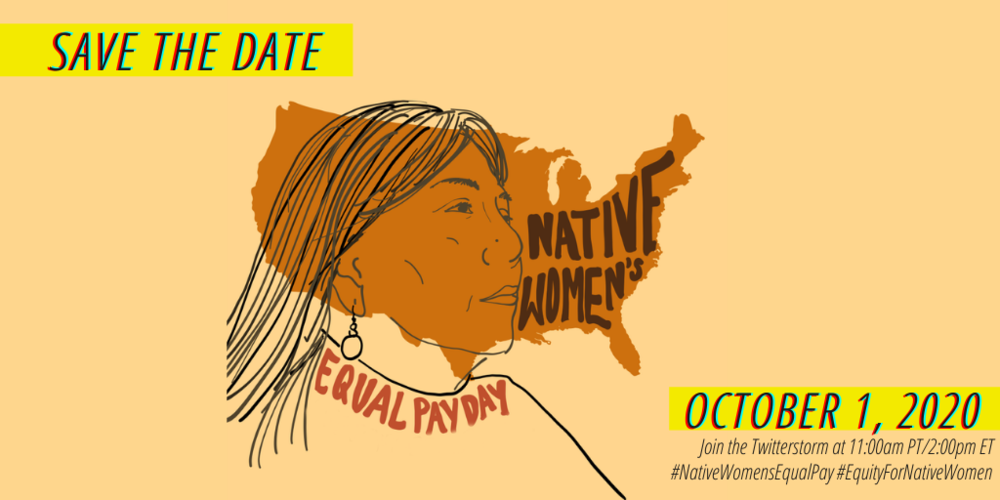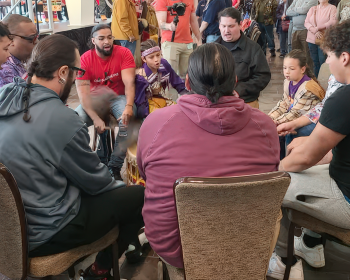
By Ariel Iannone Román
This year, Native Women’s Equal Pay Day falls on October 1, 2020, in the United States, but what exactly does that mean? The date changes year-to-year based on the amount of time a Native woman would have to work in a full-time, year-round job to earn the same amount that her white, non-Hispanic male counterpart earned in a comparable job by the close of the prior year. This year, it has actually gotten a little bit worse. In 2019, the day fell on September 23 and in 2018, the date was September 27.
Another way to put it is that Native women made $0.58 for every dollar that a white non-Hispanic man made in 2019. When considering this amount over the span of a 40-year career, the gap becomes a shortfall of $1,035,360 for a Native woman who started working full-time at age 20, in comparison to her white, non-Hispanic male counterpart. This data is based on median earnings calculated by the National Women’s Law Center using information from the U.S. Census.
Of course, to lump all Native women together can be misleading. When surveying the wage gap by Tribe, the largest gap is among the women of the Tohono O’odham Nation, whose Tribal reservation is located in Southern Arizona, though some of members of the community live in Mexico, too. Tohono O’odham women make less than half, or 46.5 percent, of what their white, non-Hispanic male counterparts make in a year. Though women from the other Tribes that were surveyed did a little bit better, the highest percentage reached was still only 68.9 percent.
Data is only as good as its collection methods, and so much of data is not disaggregated by ethnicity and Indigeneity and does not count Indigenous Peoples. According to Pamala Silas (Menominee and Oneida), former executive director of the National American Indian Housing Council: “When it comes to collecting any form of data and statistics on Native women, we are often relegated to the ‘other’ category because our issues are often viewed as relics of the past.” This is despite the fact that the 2010 U.S. Census reported that 2.9 million people identified as being solely of Indigenous heritage, while 5.2 million reported an Indigenous heritage mixed with other backgrounds.
Lauren E. Miller (Mvskoke), who is a community health worker and a member of Women Employed’s Advocacy Council Leadership Committee, writes that when she sought out more information regarding Native women via the Bureau of Labor Statistics, she found a lack of statistics on women of color in general. In 2019, Native women made up just 0.33 percent of the U.S. labor force. It’s a small enough number that data on Native women’s labor force participation and earnings has often been combined with that of Native Hawaiians and other Pacific Islanders and placed into an “other” category. Part of this is due to the fact that many Native women live in “collar counties,” so called because they border more populous counties. Researchers often fail to survey these collar counties when collecting data, missing out on a lot of information regarding the Native women who live there.
The pay gap affects all women across the globe, and this year’s Equal Pay Day in the United States, which lumps all women together into one category, fell on March 31, 2020. Native Women’s Equal Pay Day falls at a later date due to the intersection of gender discrimination, racial discrimination, and structural inequality that originated with colonization and that continues to impact Indigenous communities across the country. On top of that, there is also the COVID-19 pandemic and the current economic crisis to consider.
Two out of three Native women (64 percent) are tasked with the burden of providing some if not all of the income for their household, with the majority being single mothers. Shortage of care and long-term school closings due to the pandemic have forced mothers to work less hours, earning less income, and risking the loss of their jobs. According to the Institute for Women’s Policy Research, mothers have been 3 times more likely to have lost their jobs during the pandemic than fathers. The Institute also reports that experts are worried that the pandemic might actually set women’s progress in the workplace as much as 10 years back, especially mothers, who have to deal with not just the gender wage gap, but the motherhood gap that penalizes working women who have children.
Laws attempting to end discrimination in the workplace have been in place for over half a century. President Kennedy signed the Equal Pay Act of 1963, which amended the Fair Labor Standards Act of 1938 to include the prohibition of “sex-based wage discrimination between men and women in the same establishment who perform jobs that require substantially equal skill, effort and responsibility under similar working conditions.” He also signed the Civil Rights Act of 1964, which included the prohibition of “employment discrimination based on race, color, religion, sex and national origin.” The Paycheck Fairness Act, which has been around since 1997, was introduced in order to close loopholes in the Equal Pay Act. The most recent iteration of this act (H.R.7) was sponsored by Representative Rosa DeLauro of Connecticut and passed the House on March 27, 2019. The latest action on record was a reading of the act by the Senate on April 3, 2019. It has yet to be passed into law.
The issue is compounded by the fact that 1 in 3 Americans still don’t believe the gender wage gap exists, with 46 percent of men and 30 percent of women stating in a survey conducted by SurveyMonkey in March 2019 that they believed the issue was fabricated for political reasons. The survey sampled the opinion of only 8,566 Americans, but even so, it’s at least sufficient to illustrate the need to raise more awareness. It’s an uphill climb in a country that is still struggling to agree on whether systemic and structural inequality actually exists. Even when systemic and structural inequalities are acknowledged, the intersections of identity which impact people in different ways depending on race, ethnicity, ability, sexuality, gender aren’t always considered. A simple internet search will turn up an abundance of news articles that address the gender wage gap, though more often than not, the articles will lump all women together, or, if they do address the intersectional factors of race and ethnicity, most only mention Black and Latinx women.
Part of the problem is that the gender wage gap is a complex issue, resulting from many factors that include race and ethnicity, disability, age, access to education, and as mentioned before, the gap varies from woman to woman depending on the intersections of her identity. Some people don’t deny the wage gap, but rather suggest that it is caused by women’s “life choices,” which effectively ignores the varying array of systemic inequalities affecting women of all backgrounds at different levels. A common claim to debunk the gender wage gap is to say that the numbers are skewed because most women work in lower-wage jobs. While this can be true, depending on which intersections of identity one is analyzing, it ignores the fact that wage gap comparisons are being made between comparable occupations. Additionally, the gender wage gap actually increases for women at higher education levels. This holds true for Native women, as well. And despite the fact that more women have been going into higher education than men, this also means that they hold almost two-thirds of the outstanding student debt in the United States.
A complex problem requires complex solutions. Salary history bans, which prohibit employers from asking for salary history and potentially passing on discriminatory disparities in pay, have already started to make a difference. Self-advocacy is an important part of the solution, and women can take this free salary negotiation workshop from the American Association of University Women (AAUW) in order to polish up their skills. Advocacy from supportive individuals and organizations, voting for equity-based legislation, supporting Native leadership, and inviting Native women to participate in policy discussions will also go a long way to closing the gap.
Image courtesy of equalpaytoday.org.
Artist Credit: @Art_SADesign @shannonandersondesign



